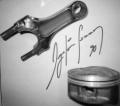CL Hyd Sys 01
by , 13-10-2012 at 10:38 PM (3003 Views)
New master cyl.
From around 2000 model, Honda modified the centre pin design and
the pushrod locking method at the CL master cyl.
It used to be a split pin inserted to the centre pin that caused bit of
headache when trying to remove it under limited space available.
Because so many master cyl leaks on our NSX, Iím getting used to
this task of removing the old split pin but on installation,
I use this later spec locking pin.
You can use it on the original design centre pin although you need bit of
effort to remove it compared to when it is used with the later spec centre pin.
Having said this, so much easier than the split pin when it comes to the removal.
It can be re-used as well.
New mater cyl installed.
Unlike the brake master cyl, you donít need to bench bleed the CL one.
Just need some fluid to prime the cyl before bleeding.
Not much point in putting lots of fluid in the reservoir at this stage as
Iím going to disconnect the CL hose later.
Just put some fluid in the reservoir, pinch the rubber hose many times to
let the air to escape and also to give the initial prime.
Then, operate the pedal with the hand several times to give some vibration
to the master cyl to push out some of the remaining air.
Then, if you open the CL hose, it will suck in fresh fluid into the system and
then time for the pressure bleeding.
More to follow later.
Kaz




 Email Blog Entry
Email Blog Entry

